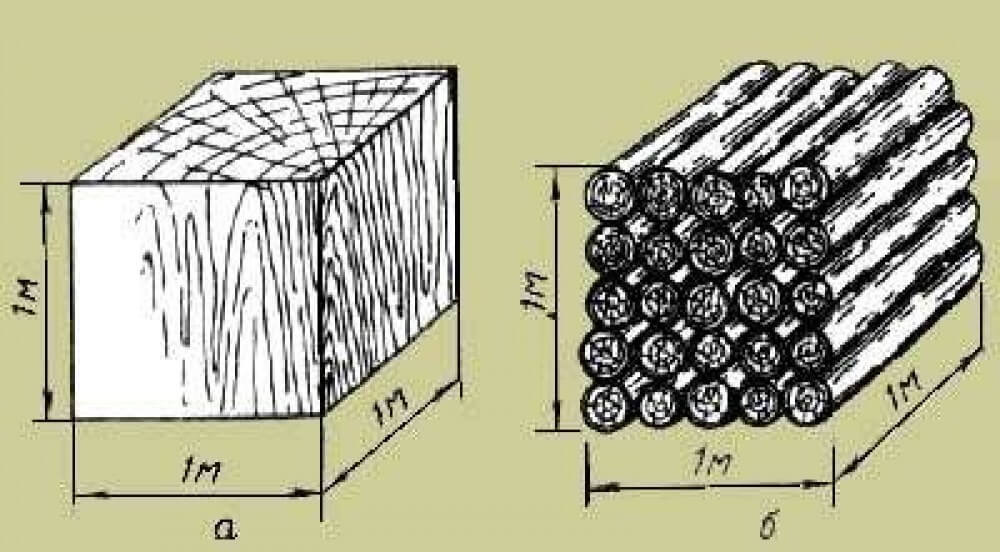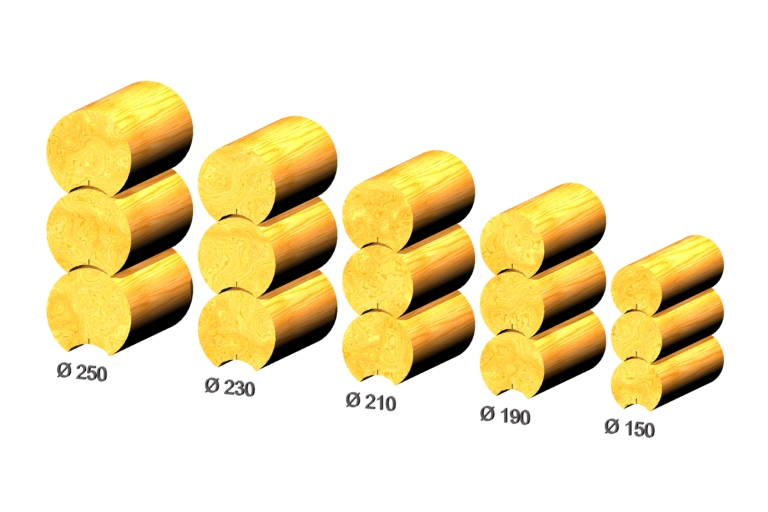When roundwood is harvested, first of all they try to accurately calculate its cubic capacity.
The measurement is made at the top cut, where the diameter will be slightly smaller. When measuring trunks that have a cross-section different from a round one, they try to measure along the narrowest cross-section, passing through the center of the annual rings of wood.
This technique is used because it allows you to most accurately estimate how much edged lumber will be obtained from one log, which has the greatest value in woodworking. Obviously, they will be cut based on the diameter of the top cut.

For the same reason, the ridge part of the trunk, where the difference between the larger and smaller cut diameters is large, is preferred to be discarded and not used in the workpiece. All the same, the sawmill will accept the wood at the upper cut.
When determining the length, measurements are made with an accuracy of 10 cm, while the length is rounded down. This accuracy is due to the fact that when felling logs, usually two cuts are made - one higher, the other lower. First, they make the lower one, then the upper one - on the other side. falls in the direction where the top of his head is leaning. The cuts are made so that the lower one is on the side where the trunk should fall.
In this case, the upper cut is made on the other side, standing in the direction opposite to the most likely fall. During the subsequent sawing of the whip, they usually cut with a saw for one cut, however, a cut error is often allowed - it can go a little obliquely, because of this there is such a large error.
Calculation by cubature
In accordance with it, you can determine the volume of each log by making measurements and choosing the value from the table. In the table, the diameter of the barrel goes in increments of 1-2 cm, and the length is 10 cm. Of course, it is not very convenient to use the entire cubature table.
This table provides data for the most common topsum diameters and lengths. Usually it is required to calculate the volume for logs up to 6 meters long. It is the logs of this length that fit into most standard bodies of ordinary ones, not specialized as timber trucks or timber trailers for tractors, it is precisely in the size of up to 6 meters that logs are cut.
Naturally, when the timber is handed over to the sawmill, we are not talking about any "rough" calculations, and it is necessary to apply the full GOST in the final calculation - after all, these are sawmills and the money of foresters who like accurate counting.
Formula calculation

V \u003d πd²l / 4, where d is the trunk diameter in the upper cut, l is the length of the log, π \u003d 3.14 - for our calculations, greater accuracy of this constant is not needed.
It is convenient when there is no GOST at hand, but only. With large volumes of work, even from three or four machines, it will take a lot of time to calculate in this way, in addition, this technique is not standardized and is not an argument in financial disputes.
Measurement of the amount of timber and sawn timber is made by volume measures, in our case, in cubic meters. In general, the calculation is carried out according to standard geometric formulas, but it may have some nuances.
Let's consider how to calculate the volume of a log.
From a geometric point of view, a log is a cylinder. Accordingly, the volume of one log is calculated using the formula for the volume of a cylinder, that is, the number Pi is multiplied by the square of the radius and length. We know the number Pi (3.1415 - for those who have forgotten), the radius is determined by measuring the diameter and dividing by 2, while the length is obtained by direct measurement. All measured values \u200b\u200bare taken in meters.
To calculate the total volume of logs, multiply the resulting volume for one log by their total. As you can see, there is nothing particularly complicated here, if not for a couple of "buts":
- The logs should be more or less close to the ideal cylinder;
- They should have approximately the same radius;
- They must be the same length;
Otherwise, this method of calculating the volume will give us an incorrect result.
That is why, when examining the purchased logs, pay attention to their correspondence to each other in diameter and length.
This technique is often used when measuring the volume of sorted timber, as well as rounded logs. The latter have been factory processed and have the same radius and length parameters, which makes the volume calculation quite accurate.
It will be easier to calculate the approximate volume of an unsorted log "by eye" by calculating the volume of an ordinary cube. The logs are stacked and measured for length, height and width. By multiplying these figures, you get the volume of the stack. Correct for the voids between the logs and the difference in diameter and length of the logs (also "by eye"), and you will get an approximate total volume of the logs.
With timber or boards, everything is much easier.
Their volume is calculated according to the method described above, only, in this case, the results of the calculations will more accurately correspond to reality. The reason is that both the board and the timber fit snugly together in a stack and have the same length. Thus, a stack of factory timber is a regular cube, and this greatly simplifies the calculation of its volume.
In addition, you can calculate the cubic capacity of a log using special tables called cubatures. Your task is to measure the diameter and length of the log, after which you need to look at the value for the corresponding indicators in the table. True, to get the total volume, you will have to measure each log in the stack and add up the individual values. On the other hand, it will give an accurate result.
When building a house from a rounded log, you need to correctly calculate the amount of required materials
The construction of a house from rounded or, as it is often called, profiled logs has always attracted a lot of attention. Indeed, in addition to the aesthetic performance, such living quarters carry naturalness, naturalness and solidity. That is why many future homeowners give their preference to this material, thereby leaving the profiled timber or log cabins without due attention. manual felling... But when planning future construction, many do not know how to calculate the cubic capacity of a log and how much to buy materials for their home. Let's try today to understand this issue and solve main problem all novice builders.
Rounded log
The process of making rounded logs takes a lot of time, because in order to get the correct cylindrical shape, the workers of the sawmills use special machines on which they remove outer layer wood (sapwood or underbore), leaving in the end only the core - the most durable part of the trunk. This is what distinguishes a profiled log from a bar. And if you take into account that ultra-precise equipment is used in the processing process, then you will never come across a cone-shaped log, as is often the case with manual felling.
Another advantage that a rounded log has is the degree of shrinkage.
If, on average, the shrinkage of a house continues for 3-4 years and during this time the tree can lose in height from 7 to 10%, then a profiled log over the same period can shrink by no more than 3-5%.
Thanks to such data, the rounded log has always had an advantage over its competitors, which is why many people prefer construction wooden house precisely from of this material... But still, how to calculate the cubic capacity of a rounded log is the main task that we set ourselves today.
Cubic meter of forest
Before you start calculating the cubic capacity of a log, you need to explain for yourself what a cubic meter of wood is.
Indeed, many often do not even suspect that the released building material, in particular a rounded log, is calculated in cubic meters.
So, a cubic meter is a unit of volume with a rib length of one meter. Simply put, the length, width and height of any material (concrete, wood, water) is equal to one meter. It is this volume that is called a cubic meter of building material. In our case, when the wooden house from a profiled log, we will only talk about a cubic meter of a rounded log.
Calculation formula

For building a house, you can purchase logs of different diameters.
Rounded logs are of different diameters. In each individual case, the owner of the future wooden house can purchase both thin logs with a diameter of 150-180 mm and thick ones - 300-350 mm. Which material to give preference to depends on the region of residence. If the air temperature in the southern regions of the country in winter does not drop below -20C °, then thin profiled logs will fit for construction. In other cases, when the temperature can drop below -40C °, it is necessary to purchase thicker materials that will help keep the house warm. Depending on the diameter and length of the log, the value of the cubic meter will also change. How to correctly calculate the cubic capacity of a log in this case?
Builders can come to the rescue State standard No. 2708-75, which regulates the volume of round timber depending on the length and diameter of the upper end. With the help of this standard, where roundwood tables are given, it is easy to calculate the volume of round logs required for construction. In cases where this document is not at hand, you can use the following calculation formula:
∏* R² *H,
where the value ∏ (pi) expresses the ratio of the circumference to the length of the diameter, R is the radius of the log, and H is the length of the log. Substituting the length (6 meters) and diameter (200 mm) of the logs under the formula, we get the following result:
3.14 * 0.1² * 3 \u003d 0.188 m³.
In other words, the formula can be expressed in such a way that in one rounded log - 0.188 cubic meters building material... Thanks to this formula, you can easily calculate the cubic capacity of a log, namely: 1 cubic meter. meter / 0.188 \u003d 5.3 logs. In this non-tricky way, you can easily calculate how many profiled logs are needed to build a wooden house.



